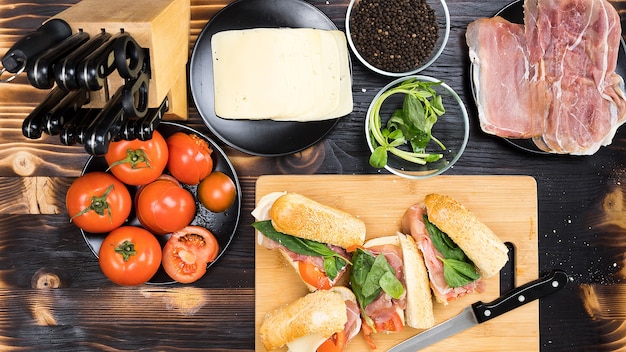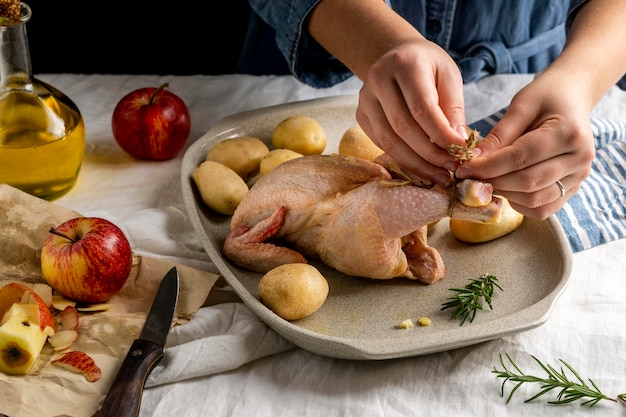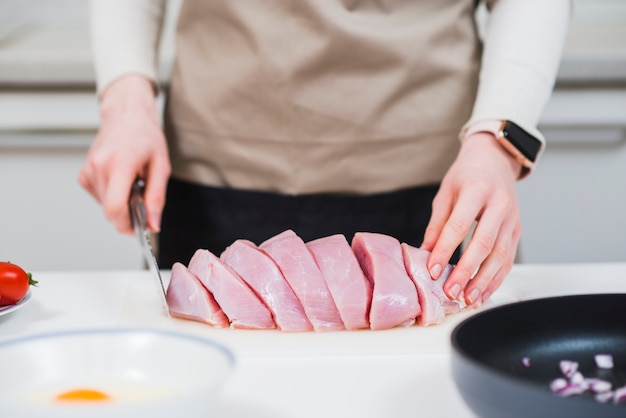Let's be honest, sometimes you just crave a hearty, soul-warming meal. And for me, that often means a succulent, fall-off-the-bone ham shank. It's a dish that screams comfort, evokes memories of cozy evenings, and, let's be real, is just plain delicious.
Now, I know what you're thinking. "Ham shank? Isn't that just a big, bony piece of meat?" Well, yes, it's certainly got some bone in there, but it's also packed with flavor and, when cooked properly, becomes a truly magnificent centerpiece.
I've been cooking for years, and I've discovered that the magic of a ham shank lies in the slow, gentle cooking process. It's about letting those flavors deepen and the meat become so tender it practically melts in your mouth. It's a dish that takes some time and effort, but believe me, the reward is well worth it.
So, grab a cuppa, settle in, and let's embark on a culinary adventure together. I'll be your guide, sharing my secrets and tips for cooking a ham shank that'll have you saying "Wow, that was incredible!" Let's get started!
(Part 1) Picking the perfect ham Shank

You can't expect a masterpiece without the right ingredients, and that's especially true for ham shanks. So, how do you choose the perfect one? Let's break it down:
1. The Meat Matters:
The first thing to consider is the type of ham. You have two main options: fresh and cured. fresh ham is what you'll find in the butcher's section, usually uncooked. It's your blank canvas for flavor. cured ham, on the other hand, has been seasoned and preserved, and it often comes pre-cooked or partially cooked. It's a great option for a quicker meal, but for this guide, we're focusing on fresh ham shanks – the kind that lets you build the flavor from scratch.
2. Look for a Good Cut:
A good ham shank should have a nice, even size with a good amount of meat. You want a shank that's free from any visible bruises or damage. Think of it like choosing a prime cut of steak – you want it to be healthy and beautiful. Don't be shy about asking the butcher for advice! They're the experts, and they'll be happy to help you find the perfect cut.
(Part 2) Preparing Your Ham Shank

Now that you've got your ham shank, it's time to prep it for cooking. This step is crucial for ensuring a flavorful and tender result.
1. The Trim:
When you bring your ham shank home, it's likely to have some excess fat and skin. Don't be afraid to trim these down. A little trimming makes it easier to cook and prevents the meat from being overly fatty. But remember, a little fat is good! It adds flavor and keeps the meat moist. You're aiming for a balance, not a complete removal of fat.
2. Score the Skin:
Scoring the skin is a bit like giving the ham shank a massage. It helps to create crispy, flavorful skin and allows the seasonings to penetrate more deeply. Use a sharp knife to make a series of diagonal cuts across the skin, being careful not to cut into the meat. Imagine you're creating a grid pattern, but keep those cuts shallow. You'll thank me later for this step.
(Part 3) Seasoning for Success

Now comes the fun part! Seasoning your ham shank is where you add your personal touch and create a symphony of flavor.
1. Simple But Effective:
For a classic flavor, you can't go wrong with a simple mix of salt, pepper, and paprika. This combo provides a beautiful base that allows the meat's natural flavor to shine through. You can add more complex flavors by incorporating herbs like rosemary, thyme, and garlic. Imagine the aromas that will fill your kitchen!
2. The Rub:
Want to take your seasoning game to the next level? Create a dry rub! Combine your chosen spices with a bit of oil or mustard. This helps create a flavorful crust on the ham shank and locks in the moisture during cooking. Apply the rub generously all over the meat and let it sit in the fridge for a few hours or even overnight. This gives the flavors time to really meld together and infuse the meat with all those delicious aromas.
(Part 4) The Braising Method: A Culinary Symphony
Braising is the key to unlocking the true potential of a ham shank. It's a gentle, slow cooking method that produces unbelievably tender meat and a rich, flavorful broth.
1. The Browning:
First, we sear the ham shank. This step is crucial for developing a rich, caramelized flavor on the outside of the meat. Heat a large dutch oven or pot over medium-high heat. Add some oil – I prefer olive oil for its flavor – and sear the ham shank on all sides, about 3-5 minutes per side. You'll see that beautiful golden-brown crust forming as the sugars in the meat caramelize. This process helps to seal in the juices and create an incredible depth of flavor.
2. The Aromatic Base:
While the ham is browning, prepare your aromatic base. This is where you add the vegetables that will infuse the broth with flavor. I like to use onions, carrots, and celery, but feel free to experiment with your favorites. Think about what flavors you love and let those guide your choices. Chop these vegetables and add them to the pot along with some garlic and herbs. The combination of these ingredients will create a truly magical broth.
3. The Liquid:
Now we need to add the liquid. I typically use a combination of beef broth and red wine, but water and even beer work well. Pour the liquid into the pot, making sure it comes about halfway up the ham shank. Think of this as a comforting bath for your ham shank.
4. The Slow Cook:
Once your ham shank is submerged, bring the mixture to a boil, then reduce the heat to a simmer and cover the pot. Let the ham shank simmer gently for 2-3 hours, or until the meat is incredibly tender and falls off the bone easily. You can tell it's ready when you can easily pierce the meat with a fork. The slow simmering allows the flavors to meld and the meat to become incredibly tender, making it a true feast for the senses.
(Part 5) Taking the Ham Shank to the Next Level: Glazing for Glory
So, you've braised your ham shank, and it's practically begging to be devoured. But why stop there? We can take it up a notch with some simple additions.
1. The Glaze:
When the ham shank is almost done, we can create a delicious glaze. Remove the ham shank from the pot and set it aside. Strain the broth through a sieve, discarding the solids, and bring the broth back to a simmer. Now, add your glaze ingredients. I love using a mixture of honey, Dijon mustard, and balsamic vinegar. These ingredients create a sweet and tangy glaze that perfectly complements the savory ham. Simmer the glaze for a few minutes, until it thickens slightly, then baste the ham shank with it. You'll see the glaze caramelize and create a beautiful, glossy finish on the meat.
2. The Finishing Touch:
While the ham shank is resting, you can cook some greens in the delicious broth. Think sauteed spinach, kale, or chard. The greens will absorb the flavorful broth, making them a perfect side dish.
(Part 6) Serving Up Perfection: A Culinary Masterpiece
Your masterpiece is ready! But how to present it? Let's make it a truly memorable dining experience.
1. The Presentation:
Presentation matters! Plate the ham shank with some of the braising liquid and your greens, making sure to arrange them attractively. You want to create a visual feast that will entice your guests.
2. The Sides:
A delicious ham shank deserves equally impressive sides. Here are some of my favorite pairings:
- mashed potatoes: Creamy and comforting, mashed potatoes are a classic side dish for ham. They provide a perfect balance to the savory, rich flavors of the ham.
- Roasted Vegetables: roasted carrots, Brussels sprouts, or asparagus complement the rich flavor of the ham. The roasting process brings out the natural sweetness of the vegetables, creating a lovely contrast with the savory ham.
- Polenta: A simple and satisfying side, polenta can be seasoned with herbs, cheese, or even a touch of pesto. It's a great way to add a touch of creamy texture and a burst of flavor to your meal.
3. The Bread:
Don't forget the bread! A crusty baguette is perfect for soaking up the flavorful broth. The bread will soak up the rich, savory flavors of the braising liquid, creating a delicious and satisfying addition to your meal.
(Part 7) Leftover Love: Transforming the Remains
Let's be honest, there's a good chance you'll have leftovers. But don't fret! leftover ham shank is even more delicious the next day.
1. The Sandwich:
The most obvious (and delicious) use for leftover ham shank is a hearty sandwich. Slice the meat, pile it high on a crusty roll, and add some of the braising liquid for extra flavor. It's a delicious and satisfying way to enjoy your leftover ham.
2. The Soup:
Turn your leftover broth and ham into a comforting soup. Add some chopped vegetables, noodles, or rice. You'll be amazed at how easily your leftover ingredients transform into a hearty, flavorful soup.
3. The Pasta:
Shred the leftover ham and add it to your favorite pasta dish for a boost of flavor. It's a simple and satisfying way to use up leftovers and create a new dish.
(Part 8) FAQs: Your Questions Answered
1. How Long Does a Ham Shank Need to Cook?
cooking time for a ham shank will vary depending on its size. A smaller shank may only need 2 hours, while a larger one could take up to 3 hours. The key is to cook it until the meat is incredibly tender and pulls away from the bone easily. You can check for tenderness by piercing the meat with a fork. If it slides in easily, you're good to go!
2. Can I Freeze a Ham Shank?
Yes, you can freeze a ham shank. Wrap it tightly in plastic wrap and then in foil. It can be frozen for up to 3 months. Remember to thaw it in the refrigerator for 24 hours before cooking. This will ensure the meat thaws evenly and prevents any freezer burn.
3. What if the Ham Shank Isn't Tender Enough?
If your ham shank isn't as tender as you'd like, you can try cooking it a little longer. Just make sure to keep an eye on it and add more liquid if needed. Remember, patience is key!
4. Can I Use a Different Cut of Meat?
While ham shank is ideal for braising, you can use other cuts of pork, such as shoulder or butt. Just adjust the cooking time accordingly. These cuts also offer a great opportunity to explore different flavor profiles.
5. What Other Spices Can I Use?
Get creative with your seasonings! Experiment with different herbs and spices, like rosemary, thyme, garlic, onion powder, paprika, cumin, and cayenne pepper. You can also use a pre-made spice rub or create your own blend. Don't be afraid to experiment and discover new flavor combinations that excite your taste buds.
And there you have it! Now, you're armed with everything you need to cook a delicious ham shank that will impress your friends and family. So, go forth and experiment! Don't be afraid to try different flavor combinations and techniques. And most importantly, enjoy the process! Happy cooking!
Everyone is watching

Prime Rib Roast Cooking Time Chart: Per Pound Guide
Cooking TipsPrime rib roast. Just the name conjures images of lavish dinners, crackling fires, and hearty laughter. It’s ...

How Long to Bake Potatoes in the Oven (Perfect Every Time)
Cooking TipsBaked potatoes are a staple in my kitchen. They're incredibly versatile, delicious, and surprisingly easy to m...

Perfect Rice Every Time: The Ultimate Guide to Cooking Rice
Cooking TipsAs a self-proclaimed foodie, I've always been a bit obsessed with rice. It's the foundation of countless cuisi...

The Ultimate Guide to Cooking Asparagus: Tips, Techniques, and Recipes
Cooking TipsAsparagus. The mere mention of this spring delicacy conjures up images of vibrant green spears, crisp and burs...

Ultimate Guide to Cooking the Perfect Thanksgiving Turkey
Cooking TipsThanksgiving. Just the word conjures up images of overflowing tables laden with delicious food, the scent of r...
